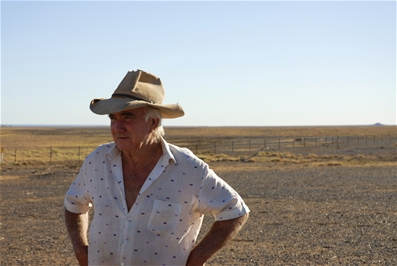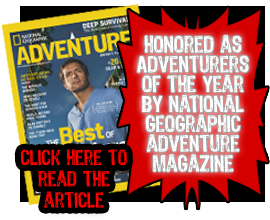Carnet de Passage? What is that? This is often the question that we get from a wide variety of people… from people who want to know more about getting their cars overseas to the very shipping companies and customs agents who are supposed to process them for you. For those of you who don’t know what they are, which is probably the majority, here is the quick and dirty.
A Carnet de Passage (fully recognized as a Carnet de Passage en Douane and literally translated into "notebook for passing through customs") is an internationally recognized document that covers the temporary admission of a foreign registered vehicle into a country. It is essentially a guarantee to foreign countries that you will not be permanently importing your vehicle and therefore are exempt from any import/export taxes or fees that may be applied otherwise. You can pass through a country without a Carnet, but it definitely makes your life a lot easier, especially if you plan of passing through a lot of them.

The concept of a Carnet is simple enough, but actually getting your hands on one is quite difficult. Here are 10 fun facts about them:
1) The only agency authorized to issue a vehicle Carnet for the United States is the Canadian Automobile Association.
2) You need to put up a financial guarantee to ensure that you bring the vehicles back. (This may be refundable if you do bring them back)
3) The financial guarantee comes in the form of an irrevocable Letter of Credit. If you have 2 late model vehicles, you have to front nearly $80,000 US cash for the LOC.
4) Most US banks don’t even know what a LOC is and when you do find one that does, they charge you $700 to write a letter informing the CAA that you have $80,000 of your money in their bank.
5) You are required to provide a plethora of information for the Carnets including engine block serial numbers… however on the Carnets that you paid an additional $400 a piece for, the value for that field is "not listed."
6) You need to explain the Carnet process to financial institutions and shipping companies at least 65 times… before you even leave the US.
7) YOU become the expert on how to execute the Carnet… even the CAA does not seem to know how they work or at leasts does not deem it necessary to tell you when you ask.
8) The Carnets do not come with instructions for how to properly execute them… you might be lucky enough to travel to an English speaking country first where a customs official will show you how it is done.
9) The Carnets are only good for one year… after that you have to pay an additional $400 a piece to renew them and in our case this has to be done overseas on the move… luckily affiliate offices exist.
10) Even if you do physically bring the vehicles back, you still might possibly forfeit all or part of the $80,000 you put up if the one customs officials you forgot to bribe in Turkmenistan forgot to put the right stamp in the right place.
Although they are helpfull, it is still a little nerve wracking knowing that you are literally driving around the world with two peices of paper that are essentially worth $80,000. Guess I better not spill any Laksa curry sauce on them.

 There is not much out there in the outback, hence the name I imagine… only a handful of small towns and cattle stations to pass through on the Stuart Highway. We covered the 1,500 km from Alice Springs up to Darwin with not much to see, although we did pull over and snap some shots as we crossed over the Tropic of Capricorn. Our stay in Australia is coming to an end and it is hard to believe that later this week we will be parting ways once again with the trucks, although hopefully for a much shorter period of time. Next move for us-getting on a plane bound for Indonesia.
There is not much out there in the outback, hence the name I imagine… only a handful of small towns and cattle stations to pass through on the Stuart Highway. We covered the 1,500 km from Alice Springs up to Darwin with not much to see, although we did pull over and snap some shots as we crossed over the Tropic of Capricorn. Our stay in Australia is coming to an end and it is hard to believe that later this week we will be parting ways once again with the trucks, although hopefully for a much shorter period of time. Next move for us-getting on a plane bound for Indonesia. 

 The friendly looking old man behind the dirty counter informed me it was across the street. Relieved I headed outside and soon found that my idea of a Hilton was much different than what lay in front of me. As I walked back inside the crew was laughing at my haste to go visit the hotel. The Hilton was actually a wide open dirt field next to where the cattle are kept. It had a proper sign nailed to a barn that was open on all sides and covered in hay.
The friendly looking old man behind the dirty counter informed me it was across the street. Relieved I headed outside and soon found that my idea of a Hilton was much different than what lay in front of me. As I walked back inside the crew was laughing at my haste to go visit the hotel. The Hilton was actually a wide open dirt field next to where the cattle are kept. It had a proper sign nailed to a barn that was open on all sides and covered in hay. 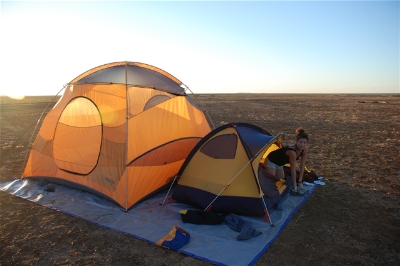 I often wonder what it must be like for the Steves to have no home. When I would talk with them about the trip before this all began, the idea of being on the road for two years seemed so rootless. The idea of fitting all the things you need into the bed of a truck sounded like crazy talk. That night in Middleton showed me that they have a home here. Their tent is their room, they are their own little family, and the world is their apartment.
I often wonder what it must be like for the Steves to have no home. When I would talk with them about the trip before this all began, the idea of being on the road for two years seemed so rootless. The idea of fitting all the things you need into the bed of a truck sounded like crazy talk. That night in Middleton showed me that they have a home here. Their tent is their room, they are their own little family, and the world is their apartment. 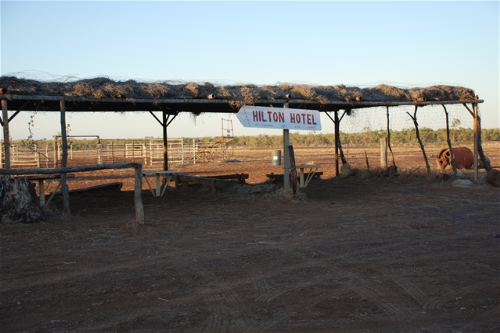
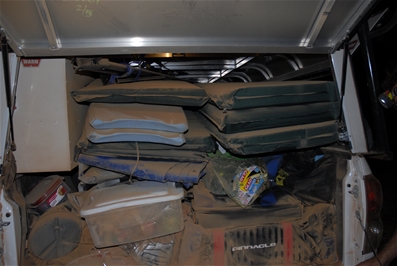 Upon arrival at our first stop on the track, we prepared to set up camp and opened the back of the Tundra only to find that nearly everything in the topper was covered in a thick layer of red dust. Dust had been blowing through the gap in the bottom of the tailgate for several hours and at a force that had even piled it up half an inch in some spots. When I say nearly everything had been covered, this is no exaggeration. Even items inside zippered luggage and sealed bins had not been spared. With jaws dropped we started to slow process of assessing the damage from this blow "pun partially intended" that was certainly below the belt. The one thing that numbed the blow to a certain extent was that it was a result of something that was not directly our fault. However, given the issues we had with customs and quarantine, there is no doubt that we have at least a day of work ahead of us once we get to Darwin to prevent further headaches when we ship the Toyotas to Singapore. Everything that was in back of the Tundra needs to be hosed out, wiped down and sterilized of the dust that has even managed to permeate the passenger cab of the vehicles… cabs that were pressurized to an extent by the use of fans and A/C. If anyone has any doubts, I am confident there will still be some hanging around when we return back to the states in a a year or two.
Upon arrival at our first stop on the track, we prepared to set up camp and opened the back of the Tundra only to find that nearly everything in the topper was covered in a thick layer of red dust. Dust had been blowing through the gap in the bottom of the tailgate for several hours and at a force that had even piled it up half an inch in some spots. When I say nearly everything had been covered, this is no exaggeration. Even items inside zippered luggage and sealed bins had not been spared. With jaws dropped we started to slow process of assessing the damage from this blow "pun partially intended" that was certainly below the belt. The one thing that numbed the blow to a certain extent was that it was a result of something that was not directly our fault. However, given the issues we had with customs and quarantine, there is no doubt that we have at least a day of work ahead of us once we get to Darwin to prevent further headaches when we ship the Toyotas to Singapore. Everything that was in back of the Tundra needs to be hosed out, wiped down and sterilized of the dust that has even managed to permeate the passenger cab of the vehicles… cabs that were pressurized to an extent by the use of fans and A/C. If anyone has any doubts, I am confident there will still be some hanging around when we return back to the states in a a year or two.
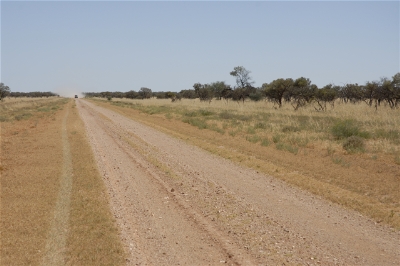 Driving in the outback is full of surprises and is not for the ill prepared or unskilled driver. Once can expect to encounter many unusual things that you wouldn’t come close to seeing on an American road. We have receive more than fair warning about the kangaroos, wallabies, wombats and other creatures that seem to be attracted to the front end of your vehicle. This phenomenon is quite evident in the overwhelming number of cars and trucks in Australia with bull bars and grill guards. Everyone looks at the Tundra and Sequoia with awe and amazement, but maybe it is because we are traveling sanz roadkill protection. Apparently, it is not a matter of if, but simply when in terms of having a close encounter with the local wildlife on the road.
Driving in the outback is full of surprises and is not for the ill prepared or unskilled driver. Once can expect to encounter many unusual things that you wouldn’t come close to seeing on an American road. We have receive more than fair warning about the kangaroos, wallabies, wombats and other creatures that seem to be attracted to the front end of your vehicle. This phenomenon is quite evident in the overwhelming number of cars and trucks in Australia with bull bars and grill guards. Everyone looks at the Tundra and Sequoia with awe and amazement, but maybe it is because we are traveling sanz roadkill protection. Apparently, it is not a matter of if, but simply when in terms of having a close encounter with the local wildlife on the road. 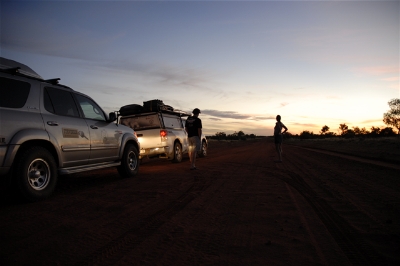 I am happy to say that we have put several thousand kilometers on the Toyotas, many of them at dusk when it is pretty risky to be on the road, all without incident… although we have had some very close calls with the roos in particular. Unfortunately, countless others were not as lucky and there are plenty of reminders on the side of the roads to assure you that the hazard is still very much there.
I am happy to say that we have put several thousand kilometers on the Toyotas, many of them at dusk when it is pretty risky to be on the road, all without incident… although we have had some very close calls with the roos in particular. Unfortunately, countless others were not as lucky and there are plenty of reminders on the side of the roads to assure you that the hazard is still very much there. A Road Train consists of the tractor and anywhere from 3 to 5 FULL SIZE trailers. These Road Trains are on average 50 meters (150 feet) long and passing one of these behemoths, trailers weaving from side to side on single lane roads is a true test of nerves and guts. On the singletrack dirt outback tracks you can see Road Trains coming from miles away as a result of the dust they kick up and when you see one coming your way you better pull off to the side of the road because they won’t.
A Road Train consists of the tractor and anywhere from 3 to 5 FULL SIZE trailers. These Road Trains are on average 50 meters (150 feet) long and passing one of these behemoths, trailers weaving from side to side on single lane roads is a true test of nerves and guts. On the singletrack dirt outback tracks you can see Road Trains coming from miles away as a result of the dust they kick up and when you see one coming your way you better pull off to the side of the road because they won’t.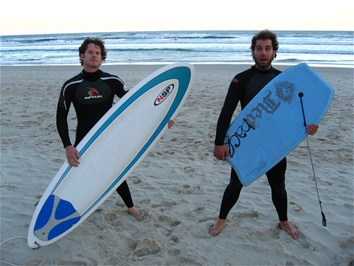 The coast of Australia is not much different than the coast of California. There are certainly some cultural differences. Nonetheless, if dropped off somewhere along the coast without knowledge of my whereabouts, the only readily apparent difference would be the accent. Attitudes and the general way of life on the coast are as close to American as I have seen since I started travelling abroad from the intense concern with liability to the inflated cost for goods. Since our mission is to uncover less known and off the beaten path things, it is easy to feel like you are failing after a month not dissimilar to a California vacation.
The coast of Australia is not much different than the coast of California. There are certainly some cultural differences. Nonetheless, if dropped off somewhere along the coast without knowledge of my whereabouts, the only readily apparent difference would be the accent. Attitudes and the general way of life on the coast are as close to American as I have seen since I started travelling abroad from the intense concern with liability to the inflated cost for goods. Since our mission is to uncover less known and off the beaten path things, it is easy to feel like you are failing after a month not dissimilar to a California vacation.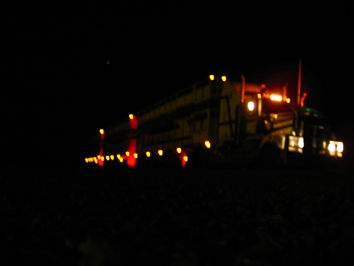 through kangaroo country. Instead of seeing signs to look for elk or deer, we see ones that have pictures of little sloths mistakenly called bears. The furry human-sized roos with huge feet, giant leg muscles, built in fanny packs, and short little arms are certainly a sight unique to this continent.
through kangaroo country. Instead of seeing signs to look for elk or deer, we see ones that have pictures of little sloths mistakenly called bears. The furry human-sized roos with huge feet, giant leg muscles, built in fanny packs, and short little arms are certainly a sight unique to this continent.